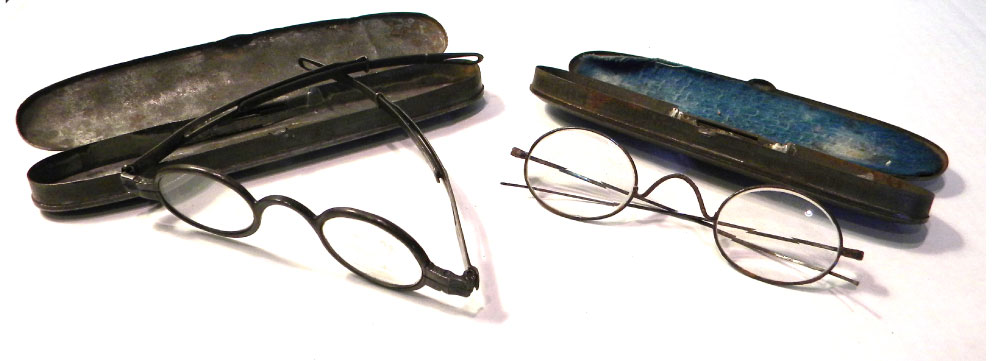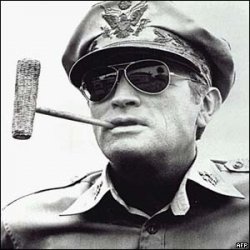Medieval sunglasses.
Although the first documented discussion of eyeglasses dates from the late 13th century in Italy, many cultures had discovered the magnifying property of convex glass lenses much earlier. English friar Roger Bacon (1214-1292) wrote about his observations of convex glass and noted that it would be useful for those with weak eyes.
Sunglasses on 18th century
There is evidence that by 1591, tinted lenses were used as protection from bright sunlight! In the 17th and 18th centuries, tinted lenses were often used a second set of lenses and attached to spectacles by a hinge. eyeglasses with tinted lenses, 1840-1880
The first eyeglasses consisted of one lens on a handle. Later, two lenses were strapped around the head using leather or silk bands. The modern, hinged temple was not introduced until the late 1700s. Before lightweight plastic and metal alloys were invented, frames were made of brass, iron, nickel, horn, bone, gold, silver, or leather.
In America during the 1700s, ready-made glasses were imported from Europe. They were expensive and unaffordable for most colonists. In the early 1800s, eye glasses were manufactured in the United States with glass lenses that were still imported from Europe. These ready-made glasses were sold by peddlers or jewelers and customers fit themselves. It was not until the 1870s that Americans learned to make optical-quality glass and to grind the lenses to specific standards that could be prescribed by optometrists.

The 1900s saw eyeglasses become an industry of their own, complete with manufacturing and distribution networks. Styles quickly changed
in this century as Hollywood and celebrities began to influence fashion and new materials became available, especially plastics.
1900-1920
As the 19th Century came to a close, more and more people wore their eyeglasses everyday. A popular style of inexpensive, everyday spectacles was the pince-nez. French for "pinch nose," the pince-nez was first developed in France circa 1840 and began to be imported to America after the 1850s.
Pince-nez have no temples, but are fit snugly on the bridge of the nose. Pince- nez could be uncomfortable to wear and broke often from falling off the nose. The popularity of pince-nez was helped by political figures such as U.S. Presidents Teddy Roosevelt and Calvin Coolidge who wore them regularly.
In the 1930s sunglasses became popular for the first time. Although colored lenses were available early in spectacle manufacturing, it was not until 1913 that Sir William Crookes of England created a lens capable of absorbing both ultraviolet and infrared light. Further advances in sunglass design were accomplished in order to meet the needs of military pilots in World War II (1939 - 1945). As a result, manufacturers began to market sunglasses that were both practical and fashionable.
 By the 1940s
By the 1940s , advances in the manufacture of plastics made a large variety of spectacles available in every color of the rainbow. Women wore frames characterized by an upsweep on the top rim, a style that was very popular until the end of the 1950s, while men tended to sport gold wire frames.
Sunglasses after the 2nd world war
By the latter half of the 20th century, spectacles were considered part of a person's wardrobe. Similar to clothes, eyeglasses needed to be continually updated or a person could be perceived as old-fashioned. More and more celebrities were influencing spectacle fashion, for example, in the 1970s Jacqueline Kennedy Onassis helped to popularize oversized lenses.
Starting in the 1980s technical innovations produced higher quality, plastic lenses. These were lighter and safer to wear





 In China, sunglasses were used in the 12th century or possible earlier. These sunglasses were made out of lenses that were flat panes of smoky quartz. They offered no corrective powers nor they protect from harmful UV rays but did protect the eyes from glare. Ancient documents describe the use of such crystal sunglasses by judges in ancient Chinese courts to hide their facial expression when they interrogated witnesses.
In China, sunglasses were used in the 12th century or possible earlier. These sunglasses were made out of lenses that were flat panes of smoky quartz. They offered no corrective powers nor they protect from harmful UV rays but did protect the eyes from glare. Ancient documents describe the use of such crystal sunglasses by judges in ancient Chinese courts to hide their facial expression when they interrogated witnesses.

 By the 1940s , advances in the manufacture of plastics made a large variety of spectacles available in every color of the rainbow. Women wore frames characterized by an upsweep on the top rim, a style that was very popular until the end of the 1950s, while men tended to sport gold wire frames.
By the 1940s , advances in the manufacture of plastics made a large variety of spectacles available in every color of the rainbow. Women wore frames characterized by an upsweep on the top rim, a style that was very popular until the end of the 1950s, while men tended to sport gold wire frames.